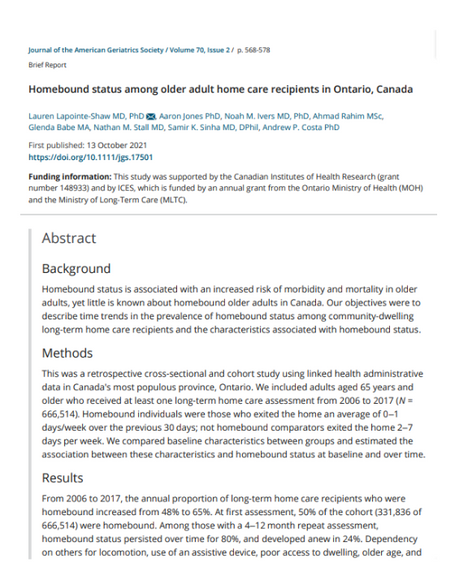Homebound status among older adult home care recipients in Ontario, Canada
Objectives of this paper were to describe time trends in prevalence of homebound status among community-dwelling long-term home care recipients and the charactierstics associated with homebound status. A retrospective cross-sectional and cohort study.
Author: Lapointe-Shaw, Jones, A., Ivers, N. M., Rahim, A., Babe, G., Stall, N. M., Sinha, S. K., & Costa, A. P.
Publication Date: October 13, 2021
Description:
Background: Homebound status is associated with an increased risk of morbidity and mortality in older adults, yet little is known about homebound older adults in Canada. Our objectives were to describe time trends in the prevalence of homebound status among community-dwelling long-term home care recipients and the characteristics associated with homebound status.
Methods: This was a retrospective cross-sectional and cohort study using linked health administrative data in Canada's most populous province, Ontario. We included adults aged 65 years and older who received at least one long-term home care assessment from 2006 to 2017 (N = 666,514). Homebound individuals were those who exited the home an average of 0–1 days/ week over the previous 30 days; not homebound comparators exited the home 2–7 days per week. We compared baseline characteristics between groups and estimated the association between these characteristics and homebound status at baseline and over time.
Results: From 2006 to 2017, the annual proportion of long-term home care recipients who were homebound increased from 48% to 65%. At first assessment, 50% of the cohort (331,836 of 666,514) were homebound. Among those with a 4–12 month repeat assessment, homebound status persisted over time for 80%, and developed anew in 24%. Dependency on others for locomotion, use of an assistive device, poor access to dwelling, older age, and female sex were most strongly associated with homebound status at baseline, as well as its development and persistence over time.
Conclusions: We found that half of Ontario older adult long-stay home care clients were homebound at the time of their first assessment, and that the prevalence of homebound status among home care recipients rose steadily from 2006 to 2017. This informs further research and policy development to ensure the adequacy of supports for older homebound persons.
Access: To read this article in full you will need to make a payment or have access to a university database
Keywords: Canada, geriatrics, homebound, older adults



